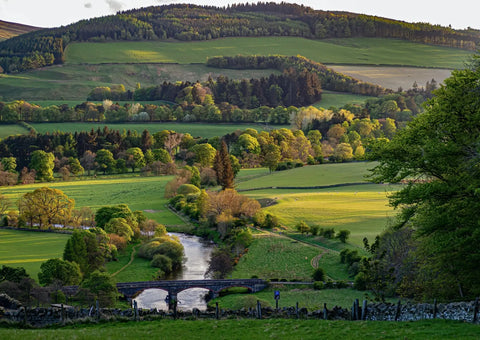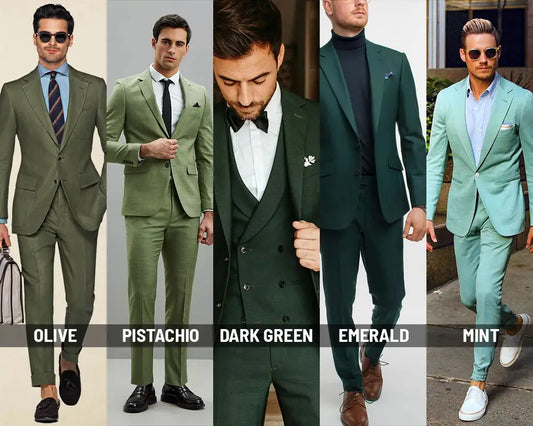In the hills and islands of Scotland, textile traditions reach sustainability and local pride, while leaving a lasting mark on haute couture and high street fashion.

The Word Tweed was Born
The original name of the fabric was tweel, Scots for twill, with the material being woven in twilling and not a simple pattern. A traditional story has a name that appears almost by chance. Around 1831, a London merchant received a letter from a Hawick company, Wm. Watson & Sons, Dangerfield Mills on some "tweels". The merchant misinterpreted the manuscript, understanding it as a brand name derived from the Tweed River flowing through the Scottish Borders textile area. The products were subsequently advertised as Tweed and the name has remained ever since.
What is Tweed Cloth Exactly?
Tweed is an image of traditional Scottish, Irish, and English clothing, which is desirable for casual wear, because the material is moisture resistant and durable. Tweeds are made to withstand harsh weather and are commonly worn for outdoor activities such as shooting and hunting in England, Ireland, and Scotland. In Ireland, tweed production is now more closely linked to Donegal County but initially covered the whole country. In Scotland, tweed production is more closely linked to Harris Island in the Hebrides.
Where does Original Tweed Come From?
The Outer Hebrides, an island chain off the northwest coast of mainland Scotland, is a remote and barren area. Without many of the adornments of modern culture, and the result is a charmingly simple place of escape. Life has been there since the Stone Age, as evidenced by the Callanish Stones, Scotland's response to Stonehenge. The population of Outer Hebrides is also small. The 2011 census reached 27,684 and this percentage has been declining for decades. However, the rate of its decline is slowing down, thanks in large part to the work of Harris Tweed Hebrides.
No city or factory owns the history of tweed. Tweed and woollen fabrics have been a part of Scotland's daily life for centuries and are worn by farmers, gamekeepers, and athletes. Like other enduring Celtic textile traditions in the country, such as tribal tartans and fuzzy Fair Isle zigzag sweaters, it is tied to geography, national pride, and the need to be engulfed in often chilly weather.
Tweed making was originally a household industry run by crafters that channelled money into the local economy in constant flow. Lady Dunmore’s (1814-1886) philanthropic love and efforts worked as catalyst for tweed cloth to be in the mainstream fashion as she in showcased the cloth to her aristocratic friends in London in 1846 and it soon became one of the fashions of the time.
How is tweed different from other fabrics?
Like many traditional Scottish practices in the countryside, the tweed is inspired by the surrounding landscape and material from fields full of sheep. Durable, all-weather textiles listen to an older and simpler way of life, its history touching on both the things of British kings and local life.
"I want my yards to emulate the patterns of nature," says Hamilton, a 27-year-old weaver, who works at The Weaving Shed in Crossbost. She learned to weave from a 90-year-old farmer in 2018 but introduces her fabrics with her own energy and colour sense. "It could be the colours of the pond or the gradation from deep plum to meadow to lilac in a thorny flower," she says. "It's a reflection of the drama in this environment."
Tweed is simply a delicate fabric of a subtle pattern that is dyed, spun, and woven from local sheep wool. Made in Scotland from the beginning of the 18th century, it was originally made of a large loom that threw out a few meters of threads painted with wildflowers and moss.
Do not mix up rough & tough tweed with the tartan, it’s posh and flashier relative, Tartans are also woven, but are spread in two or more colours with thick cross-shaped patterns and are made from wool, silk, or blend. Tweed is best for hunting, shooting, or tracing of animals; Tartan is the ceremonial and tribal pride cloth made into kilts and other legendary Highland chieftains.
Life of Tweed through times of Ups and Downs
During the first half of the 20th century, the tweed industry flourished and then declined rapidly in the second half, in part due to the growth of synthetic cloths. The 1993 Harris Tweed Act was passed to protect the industry, to which much of the residents of Outer Hebrides are committed and depend upon. The law set strict production requirements and steps, which led to the approval and quality of the "Orb" stamp. Created in 1911, it is the oldest British brand in continuous use.
Harris Tweed has been around for hundreds of years. Called clò-mòr in the Gaelic language, it is characterized by having rich waves of colour and must be made by hand with a fabric consisting of 700 or 1400 individual threads. The thick fabric still retains locally woven and dyed pieces from the islands and woven from pure virgin wool.
Few fabrics like Harris Tweed have been able to maintain their position. From street clothes to high fashion, street clothes to bespoke clothes, Harris Tweed is everywhere. "We are careful and identify with whom we deliver the product to," says Mark Hogarth, the Creative Director of HTH. "We produce a luxury product and by creating a luxury product with a unique background and trend, you have the ability to attract a wide range of customers for a variety of reasons." By nature, Tweed is durable, adaptable to all weather conditions, durable and easy to work with. Infinite colours and patterns meet the needs of all people with different styles and tastes.
"Harris Tweed is running in our veins," said Lorena McAuley, CEO of Harris Tweed. "It was built by socially isolated populations and you cannot ignore the economic, historical, historical and cultural significance of the web for island life."
In contrast to the flamboyant parts of the Outer Hebrides, tweeds from the Scottish border and highlands have plain brown aristocratic green camouflage sounding patterns, reminiscent of gamekeeper suits and pipe bands. Around them, the soft waters of Tweed, Teviot, Jed, Ettrick, and Gala wash their threads and feed the mill. Today there are only a few mills are left.
The production process is vertically integrated and as per the law HTH uses new Cheviot wool, mainly from the Scottish Lowlands. The bales are delivered to the mill, and the first step is to rub the wool in soda water before soaking it in a dye pit for two hours. This ensures that every micron of fibre is saturated with colour. There are approximately 50 natural base colours, all inspired by the nature of the island and the exquisite variety of shades. The wool is then mixed by hand and by machine to break up the larger portions of wool dyed with other colours. From this stage, the wool enters the carding process, which straightens and mixes the fibres along a series of conveyors and rollers.
There is a similar mix of heritage and fashion in the Highlands, where tweed serves as the foil to most ritual tartans. "There is no real limit to the number of colours used in modern design," says Alan Scott, Johnstons of Elgin creative director. "You can use 6-8 colours in a mix or 16 colours in one twist. There are hundreds of colours in a tweed."
After the carding process, the wool is spun rotated eight to nine times twice to form a thread, each of which has one ply and at least two colours. Then finish in a yarn cone and according to plan, order alternately in a wooden warping frame. The compact warp consists of 1,416 single pieces, 24 of which are bevelled, which must be fastened by hand, for up to two hours demanding labour and attention.
Another requirement of the law is that the fabric should be woven by independents who weave their own houses to walk on. HTH provided the weavers with a circle and a design card and, as a result, they used the weave. Currently there are more than 200 active weavers, and 95 percent of them work in double-width Griffiths loom, which is 150 cm wide. The double-width blanket is HTH's most modern arsenal equipment and "was designed to meet the needs of a changing British textile industry in the 1970s," Hogarth said. Calum George Buchanan, one of the youngest weavers, looked at the Atlantic from his blanket and described his work as "very peaceful. It was a good quality of life."
Tweed in Fashion, Politics and Media
Tweed moments last in history, closing in and out of style. One of his biggest supporters was Prince Albert, who bought Balmoral Castle in Aberdeenshire with Queen Victoria in 1853. Estate Tweeds, woven fabrics for the workers and residents of the Highlands estate, were famous at the time. The prince helped create a colourful granite and red heather pattern to represent the digs of the royal family and still in use today.
Since the creation of HTH, the presence of fabric in the fashion industry has increased tenfold, but it was originally used as a high-performance fabric. Caused a durable fabric madness among the swellings in 19th century London. The strong bespoke sewing of Savile Row turned the tweed fabric into well-cut jackets and suits fit for high society. "Prince Albert was the original torchbearer of the tweed tradition," said Christy Hassard, curator and fashion historian at Victoria & Albert Dundee, the Scottish outpost of the London Museum of Design. The tweed became such a symbol of status that Arthur Conan Doyle wore his imaginary Sherlock Holmes carriage with a tweed deerstalker hat in 1893.
To this day, British Royalty still sport the fabric. Queen Elizabeth II does the sensible woollies with wellies at Balmoral, and the industry is supported by the younger royal generation. "This thread passes through the Duchess of Cambridge [Kate Middleton], who chooses designers who use tweets in an innovative way," says Hasard. Princess Kate has been photographed in tweed miniskirts and fashionable dresses by British companies such as Alexander McQueen and Catherine Walker.
By the 20th century, tweed had become popular around the world. its rich weaves and checks reflected on professional golf pants, Ivy League teachers' jackets and haute couture. In the 1920s, Parisian designer Coco Chanel was moved by tweed after borrowing her lover's jacket. She started introducing nubby Scottish (and later French) varieties into her costumes and dresses. John F. Kennedy and Sean Connery sported Tweed jackets in the 1950s and 1960s. Even Sir Edmund Hillary and Tenzing Norgay appeared in tweed to reach Mount Everest.
Scottish tweed is almost as popular in the US as it is in the UK. When the ivy or sleek look first came into vogue in the 1960s, an astonishing 70% of UK’s Tweed's global sales went to the East Coast of the United States. The collegiate style of cloth, the New England-Meet-Old England style, still appears in US retailers, including Todd Sinder, Brooks Brothers, Boden and Supreme, often in unexpected shapes like baseball caps and bags.
In the UK, young designers are also embracing Scottish tweed, including Glasgow Charles Jeffrey, whose Loverboy label uses tartan in unexpected, unisex clubs. Daley, whose menswear grids patterns reggae, African shapes, and tweed.
“Tweed is a trendy statement that speaks of tradition,” says Hasard. “But it also remains a leader because of its practicality and impressive looks. All of the blue and gold beaches of the Hebrides and the greens and brown of the Highlands are reflected in its colours, and this sets tweed apart from any other fabric."







